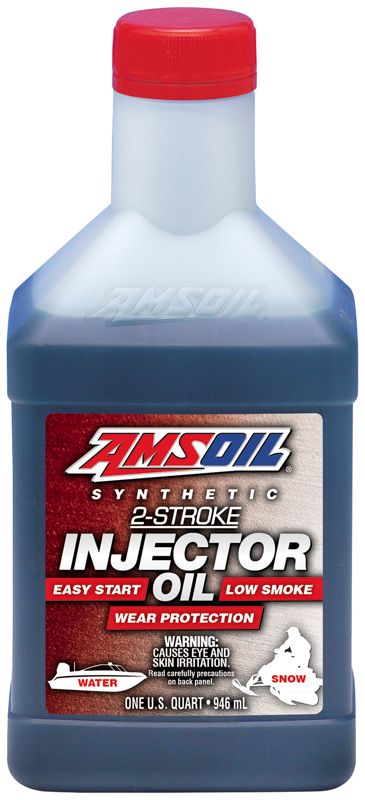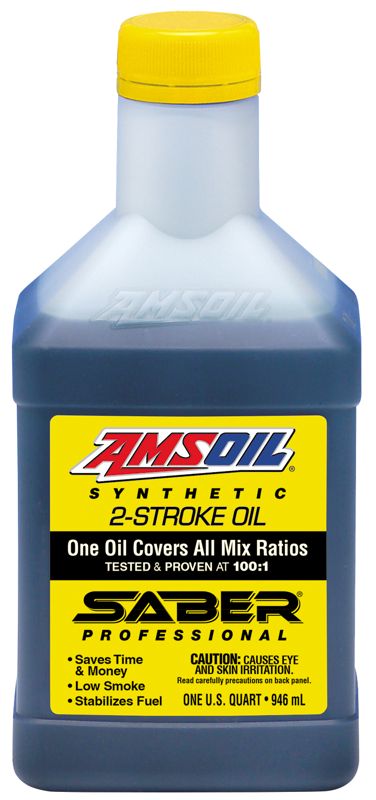Synthetic 2-Cycle Oil: What You Need to Know About 2 Stroke Oil
Top Ten Advantages for AMSOIL Dealers
August 10, 2017AMSOIL Smashes the Industry Standard – Again
September 7, 2017Synthetic 2-Cycle Oil: What You Need to Know About 2 Stroke Oil
In the world of 2-stroke oil, there are two basic offerings on the market: petroleum-based oils and fully synthetic oils. Additionally, a number of manufacturers offer various blends of petroleum and synthetic oil. Synthetic oil has proven to be best for 2-stroke engines.
What makes synthetic two-stroke oil different?
 Petroleum-based 2-stroke oil is “natural” in that it is made from fossil fuels – many 2-stroke enthusiasts refer to it as dino oil. While it provides adequate lubrication to the engine while it’s running, and aids in appropriate combustion, petroleum-based oil also leaves behind significantly more deposits than synthetic oils. Deposits range from gummy build up in valves to grimy deposits on spark plugs. Additionally, petroleum-based products have higher emissions than their synthetic counterparts. This is partially caused by the need for richer mixtures, because petroleum-based products have solvents to provide miscibility—the ability to mix with gasoline, and solvents are not lubricants. Synthetic 2-stroke oil products have lower deposits and emissions largely to having a lower ash content, and some, like AMSOIL recommend leaner mixtures (so you use less). For these reasons, a number of manufacturers now recommend synthetic oil for 2-stroke engine use.
Petroleum-based 2-stroke oil is “natural” in that it is made from fossil fuels – many 2-stroke enthusiasts refer to it as dino oil. While it provides adequate lubrication to the engine while it’s running, and aids in appropriate combustion, petroleum-based oil also leaves behind significantly more deposits than synthetic oils. Deposits range from gummy build up in valves to grimy deposits on spark plugs. Additionally, petroleum-based products have higher emissions than their synthetic counterparts. This is partially caused by the need for richer mixtures, because petroleum-based products have solvents to provide miscibility—the ability to mix with gasoline, and solvents are not lubricants. Synthetic 2-stroke oil products have lower deposits and emissions largely to having a lower ash content, and some, like AMSOIL recommend leaner mixtures (so you use less). For these reasons, a number of manufacturers now recommend synthetic oil for 2-stroke engine use.
What is synthetic two-stroke oil suitable for?
Synthetic 2-stroke oil is a great choice for any 2-stroke motor you rely on, for work or play. Racing engines, marine engines, snowmobile engines, lawn mower motors, and other light equipment including hand-held equipment. In short, any 2-stroke motor is a suitable place to use synthetic oil specially formulated for 2-stroke engines. Particularly where motors that have seasonal use are concerned, high-quality synthetic 2-stroke oil can be useful as among the additives you’ll often find fuel stabilizer.
What type of synthetic two-stroke oil is best?
The answer to that question really depends on your 2-stroke engine. AMSOIL has developed an extensive line of oil for 2-stroke engines optimized for specific equipment applications. These oils include:
- HP Injector Synthetic 2-cycle engine oil: great for outboard engines, personal watercraft, and jet boat motors; for any marine applications specifying TC-W3.
- INTERCEPTOR: primarily optimized for snowmobiles, EFI, DFI and carbureted applications, and where API TC oils are recommended; premix at 50:1 or as an injector oil;
- DOMINATOR Synthetic 2-cycle Racing Oil: for high-performance stock or modified two-stroke engines, including air- or liquid-cooled snowmobiles, personal watercraft, motorstrokes (moto X), ATVs, go-carts and outboard motors. Good for use with coated or non-coated pistons, high-octane racing fuels and exhaust power valves. Use in oil-injected and pre-mix applications that require API TC oils. In pre-mix applications, DOMINATOR delivers outstanding protection at 50:1 (2.6 oz. oil per U.S. gallon of gas), although many racers modify the mix ratio to suit their setup. (Not suitable for use with alcohol or nitro-methane fuels).
- Saber Professional 100:1 Pre-Mix: optimized for use in all two-stroke handheld equipment where JASO FD, ISO-L-EGD or API-TC oils are specified, such as chain saws, weed eaters, blowers and similar garden equipment; and
- Saber Outboard 100:1 Pre-Mix: for pre-mix use in two-stroke outboard motors, personal watercraft and jet boats that specify TC-W3. For maximum performance, mix with gasoline at 100:1 regardless of the mix ratio specified for the equipment. Richer mix ratios may be used where desired.
AMSOIL two-stroke oils are compatible with most two-cycle oils; for best performance mixing with other two-cycle oils should be minimized.
Truly, which oil is best varies depending on your engine and application. Read the original equipment manufacturer’s recommendations thoroughly, and refer to the specifications of the synthetic oils before making a choice or adding new oil to your systems. Use the AMSOIL Two-Stroke Oil optimized for your application.
What are some of the benefits of using synthetic 2-stroke oil?
 As with so much in the world of engines, performance may vary. But making the switch from traditional fossil-fuel based oil to synthetic 2-cycle can provide a number of perks, including:
As with so much in the world of engines, performance may vary. But making the switch from traditional fossil-fuel based oil to synthetic 2-cycle can provide a number of perks, including:
- Increased efficiency;
- Decreased emissions;
- A boost to performance;
- Overall cost savings (through lower maintenance and less reliance on additives);
- Reduced downtime for repairs; and
- Increased equipment life
Additionally, you will be able to rest easier knowing that you’ve taken a proactive step toward maintaining your motor for the long term.
A final point about synthetic 2-stroke oil versus petroleum-based products: your friends might try to sway you away from making the switch due to the slightly higher price of a product like AMSOIL’s. The facts are you are likely to increase the engine life of your motor and decrease your maintenance costs. So even if there is a hgher price, the cost is much less. That’s why professional race teams, landscaping companies and enthusiasts all over the United States and Canada chose AMSOIL Synthetic Two-Stroke Oils for their equipment.
How Does 2-Stroke Differ From 4-Stroke Oil?
Choosing a 2-stroke oil or a 4-stroke oil essentially depends on the type of engine your vehicle has. The oil used corresponds to the type of engine. Four-cycle engines do not require the mixing of oil and fuel in order to run.
What 2-Stroke Oil Does
Because it is necessary for combustion, 2-stroke oil needs to mix with fresh fuel outside of the crankcase. Most times, you’ll see a 50:1 two-cycle oil mix ratio or a 100:1 two-cycle oil mix ratio with gallons of fuel making up the greater portion of the mix.
Why You Can’t Use 4-Stroke Oil in a Two-Cycle Engine
The oil in standard four-cycle engines circulates separately from the fuel, so its formulation is different. Problems occur when performance-robbing carbon deposits occur in the engine. Carbon can form on components such as the piston crown, ring groves, in the exhaust port or on the spark-arrestor screen. Therefore, it’s important to use the right oil for your engine to keep your fuel system clean.





